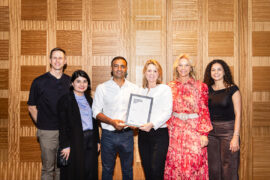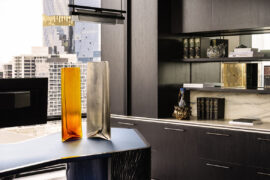Find out how Greenway Architects play with materials and colours to design a number of police stations with a strong civic presence, regional context and to reflect the SAPOL brand to shift public perceptions.
The architectural presence of the police – namely, the police station – often receives little attention despite being ubiquitous in communities across Australia. In recent years’ police stations are being redeveloped, refurbished and built new, in order to adapt them to contemporary models of policing and to assert and foster a fresh perception of the police force in the community.
In South Australia, Greenway Architects has worked with South Australia Police (SAPOL) to replace old stations with new facilities that better serve the community and promote SAPOL’s civic presence. “It is important that these facilities reflect the image of modern, contemporary and accessible police force,” says Simon Frost, Director of Greenway Architects. Indeed, by balancing the fundamental requirement that a police station be secure yet approachable, and by playing with materials and colours, Greenway Architects has designed a number of buildings with a strong civic presence and regional context that reflect the SAPOL brand.
“Both physical and visual security are important, yet these can sometimes counteract the desire for openness and transparency,” Simon explains. “Therefore, direct access from the street frontages and engagement with the public realm is important in making the public comfortable in accessing the police station and interacting with the officers within.”
In the beachside suburb of Adelaide, Henley Beach Police Station has a compact mid-century form, floating roof plane and expansive perimeter with geometrically patterned precast concrete and recycled jetty timber. “This fencing reduces the visual massing of the building and is a valuable element of the site’s interaction with the public realm,” Simon says. It is also designed that when viewed head on, the building appears visually closed, but when approached via the footpath the building is open with a sloped walkway to a light-filled entrance.
In Roxby Downs, the new police station is an inward-facing building (to withstand extreme variations in temperature) with a strong regional aesthetic. Its closed form has textures and colours reminiscent of the surrounding Strzelecki Desert and is protected by a long verandah referencing the traditional vernacular. Meanwhile, Murray Bridge Police Station is composed of a very different palette with polished black precast concrete, raw concrete blockwork and glazing to provide indirect visual accessibility to the site.
Despite being aesthetically very different, these police stations have one thing in common: different material and colour palettes have been used to shift public perceptions. Designed to be, look and feel secure, the buildings are in fact open, welcoming and approachable, promoting a modern and accessible image of the police in the community.
INDESIGN is on instagram
Follow @indesignlive
A searchable and comprehensive guide for specifying leading products and their suppliers
Keep up to date with the latest and greatest from our industry BFF's!

London-based design duo Raw Edges have joined forces with Established & Sons and Tongue & Groove to introduce Wall to Wall – a hand-stained, “living collection” that transforms parquet flooring into a canvas of colour, pattern, and possibility.
The new range features slabs with warm, earthy palettes that lend a sense of organic luxury to every space.

For Aidan Mawhinney, the secret ingredient to Living Edge’s success “comes down to people, product and place.” As the brand celebrates a significant 25-year milestone, it’s that commitment to authentic, sustainable design – and the people behind it all – that continues to anchor its legacy.

In this comment piece by Dr Matthias Irger – Head of Sustainability at COX Architecture – he argues for an approach to design that prioritises retrofitting, renovation and reuse.

The winners of two major Powerhouse design initiatives – the Holdmark Innovation Award and the Carl Nielsen Design Accelerator – have been announced with the launch of Sydney Design Week 2025.
The internet never sleeps! Here's the stuff you might have missed

A recent exhibition at the Robin Boyd Foundation in Melbourne invited visitors to think deeply about sheds and what this under-appreciated building typology can teach us about construction and living today.

Mim Design and Konstance Zaharias collaborate to design an interior for a unique context: the chambers of a King’s Counsel in Melbourne.